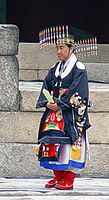Mianfu
This article needs additional citations for verification. (December 2015) |

Mianfu (Hanzi: 冕服, pinyin: miǎnfú), literally means "Coronation Costume", is a kind of Chinese clothing worn by emperors, princes and kings during imperial China, from the Shang Dynasty until Ming Dynasty.
Mianfu is the highest level of formal dress worn by emperors and royal family in special ceremonial events such as coronation, morning audience, ancestral rites, worship, new year's audience and other ceremonial activities.
Construction and design[]
The mianfu is a set of clothing, which includes a crown called mianguan (冕冠), looked like a board which leans forward and had chains of beans at the front and back.[1] Usually, the mianguan has 12 chains, however, it could also vary in numbers (i.e. 9, 7, 5, 3) depending on the importance of an event and in rank difference.[1] To fasten the mianguan to the hair, hairpins are used.[1]
The upper garment of the emperor's mianfu is usually black in colour while the lower garment is crimson red in colour in order to symbolize the order of heaven and earth.[1] The upper and lower garment are tied with a belt. A pure red coloured bixi (蔽膝; a knee covering), an important component for ceremonial clothing, hangs down under the belt.[1]
Twelve Ornaments, including the dragons, are the usual decoration of mianfu.[1]
The shoes worn by the emperor which goes with the mianfu is made of silk with double-layered wooden soles.[1] The shoes could vary in colour depending on events, and by order of importance, the emperor would wear red, white, or black shoes.[1]
History[]
Mianfu was first developed in the Shang Dynasty,[2] and later improved and standardized during the Zhou Dynasty. It was used by every dynasty from Zhou onward until the collapse of the Ming Dynasty. After the Manchu conquerors established the Qing Dynasty, the new government initiated a policy that forbade Han Chinese to wear Hanfu. Qing emperors did not use Mianfu as the emperor’s official garb, which eventually resulted in this style of clothing disappearing from use.

Emperor Wu of Northern Zhou wearing mianfu

Emperor Wu of Han wearing mianfu

Illustration of mianfu in Ming dynasty book《明宫冠服仪仗图》.
Influence and derivatives[]
Due to the strong cultural influence China exerted on its neighbours, Mianfu was also worn by rulers in other East Asian countries that belonged to the so-called Sinosphere, such as Korea (in the form of myeonbok), Japan and Vietnam during the imperial era.

Mianfu which is called myeonbok in Korea

Japan Emperor Kōmei's Mianfu
See also[]
References[]
- Chinese traditional clothing
- Court uniforms and dress





